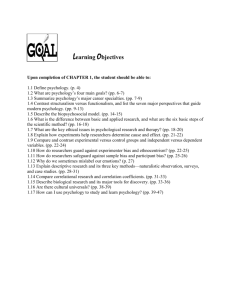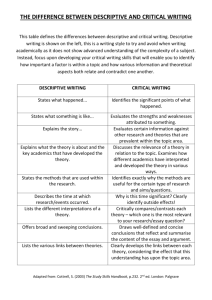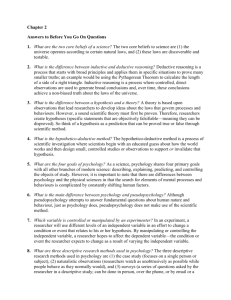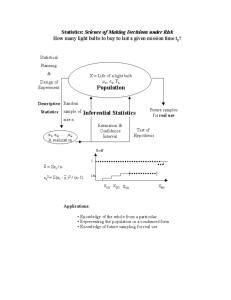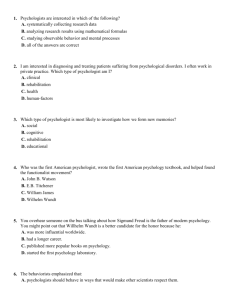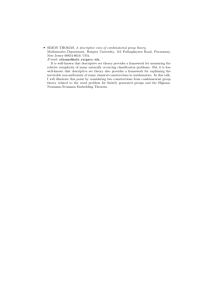Experimental Method
advertisement
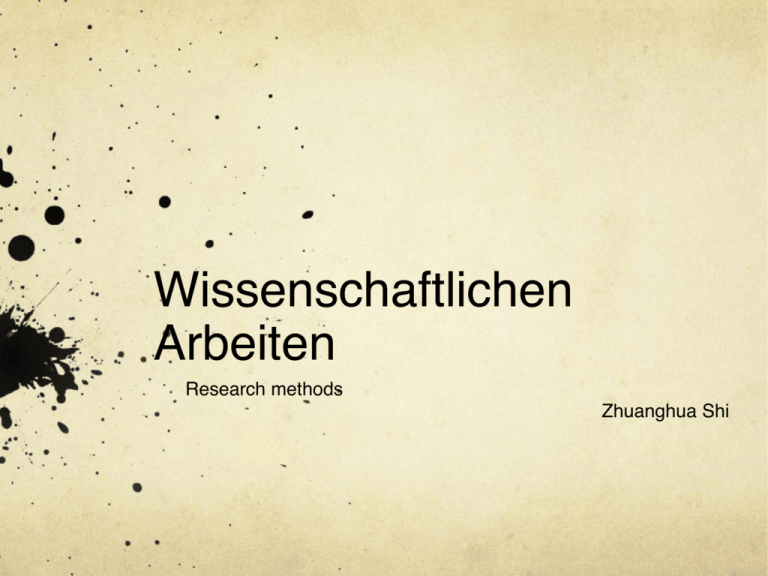
Wissenschaftlichen Arbeiten Research methods Zhuanghua Shi Scientific research cycles questions Using right format & Style Research report Using right methods Validate it using scientific methods Literature research Hypothsis Using right tools and right reading behavior Research methods Descriptive Method– to describe the nature of situation and to explore the causes Experimental Method - one variable is manipulated while another variable is observed and measured. Used to establish cause-andeffect relationship between variables Descriptive Research Ways of obtaining descriptive information Asking participants to provide information e.g. Interview Observation Communication between investigator and participants Activity Analysis: actual behavior of the participants Situation analysis: determines the sets of conditions in which the behavior of the participant occur. Types of Descriptive Research Case studies E.g. a special patient Study in depth Be aware: lack of generality Surveys Gathering data from a relative large samples Determining variables rather than about individuals Random sample Be aware: Unrepresentative samples (internet surveys?) order of questions (order effects), response options, and the wording of questions Types of Descriptive Research Developmental studies Reliable information that deals with the progress or stages of development of an individual Investigating a progression Methods Longitudinal method: Study of participants over an extended period of time Cross-section method: Study of participants in different level and focus on characteristics Types of Descriptive Research Follow-up studies To investigate the subsequent development of participants after a specified treatment or condition Documentary analysis Content analysis Gathering information by examining records and documents Types of Descriptive Research Correlational analysis To determine the extent to which different variables are related to each other. e.g., # of hours of media exposure to violence & level of aggression e.g., certain illness and optimism/pessimism To estimate a relationship (distinguished from simple descriptive methods) Be aware: Correlation ≠ Causation Advantages/Disadvantages of descriptive method Advantages All information is gathered It can be applied to a broad range of studies Disadvantages Any method has its own limits, be aware of this Tend to avoid statistical analysis, merely information gathering Variables under study are hardly controlled. Example of descriptive method Mashmallow experiment http://www.youtube.com/watch?v=6EjJsPylEOY Experimental method Experimental Psychology Industrial Psychology Social Psychology Developmental Psychology Experimental methods Applied Psychology Clinical Psychology Educational Psychology Experimental methods Used to examine cause-and-effect relationships Cause effect Two essential characteristics: Researcher has control over the experimental procedures to make sure that everything (but the variable being manipulated) stays the same. Researcher manipulates one variable by changing its value from one level to another. A second variable is observed (measured) to determine whether the manipulation causes changes to occur Participants are randomly assigned to different treatment conditions (they cannot self select). Example: Hermann Grid illusion Manipulate variable: ? Example: Scintillation Compared to classical Hermann Grid illusion, which variable has been manipulate: ? Variables Independent Variable (IV) variable that we expect causes an outcome the antecedent event variable that the experimenter can control and manipulate Dependent Variable (DV) the “effect” the outcome variable it’s value depends on the changes introduced by the IV Extraneous (Confounding) Variables Potential source of error in an experiment; must be held constant across conditions Independent variables and Conditions Must have at least two conditions (also called “levels”) of the IV in order to demonstrate that the IV has an effect on the DV. Otherwise, it wouldn’t be a ‘variable’. Experimental condition (IV present) vs. control condition (IV not present) Those in control condition receive no treatment or receive neutral, placebo treatment. Provides baseline for comparison with experimental condition. Example Curvature of Hermann Grid Experimental condition - curvature Baseline condition – linear grid Dependent variables Out come effects Behavioral responses Yes/No (perceived or not) Multiple choices Rating (confidence) Saccades Neurophysiological measures Continuous output (EEG, MEG measures) pupil dilations Heart beats etc. Extraneous (Confounding) Variables In reality, there are many other factors (variables), which may influence on the results (outcomes) – confounding variables They influences the validity of the experiment Experimental bias Experimental Bias Experimental Bias When an investigator has certain expectations about the outcome of an experiment, these expectations may contaminate the entire experience. Incentive / motivation The experimenter can subtly alter his or her behavior in carrying out the experiment in a number of ways and so produce biased results, such as instruction As fast as possible vs. As accuracy as possible Control experimental bias Placebo control Placebo effect: provides no active effect Use in identical conditions for control and experimental groups Blind experiment Researchers blind to group membership of participants to rule out experimenter bias Strongest experiments – double blind design Researchers and participants kept blind Control experimental bias Double blind Experiment Control other factors Laboratory Experiments Experimental environments E.g., temperature, ambient light in room Same setting: viewing distance etc. Participants Age, sex, visual acuity (balanced) Randomization Morning / Afternoon Control other factors Field Experiments Conducted in real-world Advantage People are more likely to act naturally Disadvantage Experimenter has less control (“quasiexperiments”) Quasi-independent variable Typically something the experimenter cannot manipulate such as gender or smoking Control methods Balance the survey using large samples(gender, sex) Using different days Control other factors: Groups Within-subject design All participants exposure to all conditions Randomization Within-subject comparison Between-subject design Experimental group vs. control group Patient studies Random assignment Sex, age, education should be balanced Theory and hypothesis Theory A set of statements designed to explain a set of phenomena more encompassing than a hypothesis Hypothesis A statement, usually designed to be tested by an experiment that tentatively expresses a cause-and-effect relationship with variables. Operational definition What Makes a Good Theory? Incorporates existing facts It is testable Predictions made by the theory are supported by the findings of new studies It conforms to the law of parsimony From Theory to Testable Questions Operational Definition A specific, observable response that is used to measure a concept Validity – the ability of a test to measure what it was designed to measure. Are we really measuring what we say we are? Reliability – the repeatability of a measurement. Basically, the extent to which the measurement device yields the same approximate results when utilized repeatedly under the same conditions. Constructs & Operational Definitions Empirical Realization translating the conceptual or abstract variables contained in your hypothesis to real, measurable constructs constructs – abstract level operational definition The specific way in which a construct is manipulated or measured Examples Crusco & Wetzel (1984) interested in how touching influences individuals’ perceptions of others description of study waitress performed normal duties when she gave change to customer, she approached the paying customer from the side, leaned forward, and w/out making eye contact, said in a friendly yet firm tone, “Here’s your change.” 1/3 – no touch control condition 1/3 – a brief hand-touch condition 1/3 – a longer shoulder-touch condition left a blank survey for customers to complete collected survey and tip Examples Crusco & Wetzel (1984) IV: nature of physical contact DV: ratings of waitress on Questionnaire and amount of tip Touch has a positive effect on tipping behavior. When patrons are touch by a waiter or a waitress, they became more generous and left a higher tip. Examples The effects of mood on helping (Isen & Simmonds, 1978, Social Psychology, v41) researchers go to shopping malls and set up observation near phone booths. Their participants are individuals who use the phone booths when the vicinity is otherwise unoccupied. For half of the Ps, the researchers leave a quarter to be found near the booth. For all of the Ps, when the phone call is completed and the person leaves the telephone booth, a confederate walks by the booth, and drops a file folder full of papers. The researchers watch to see if the Ps help pick up the dropped papers. Examples Constructs IV: Mood DV: Helping Operational IV: finds a quarter DV: help pick up paper Putting people in a good mood leads them to be more helpful. Examples Researchers are interested in the interference effects (Stroop effect) of font color on word naming task. They use the words as shown on the right. Participants are instruct to name the word as quick as possible, meanwhile they should avoid their errors. ORANGE BLUE GREEN YELLOW ORANGE GREEN PURPLE GREEN BLACK YELLOW Examples Stetson, Fiesta, & Eagleman, 2007, Does Time Really Slow Down during a Frightening Event? Abstract level: ? Operational level: ? Summary: Research methods Descriptive method case studies, survey, developmental study, followup study, documentary analysis, correlation analysis Experimental method variables and conditions Experimental biases Theory and hypothesis construct operational definition !35

